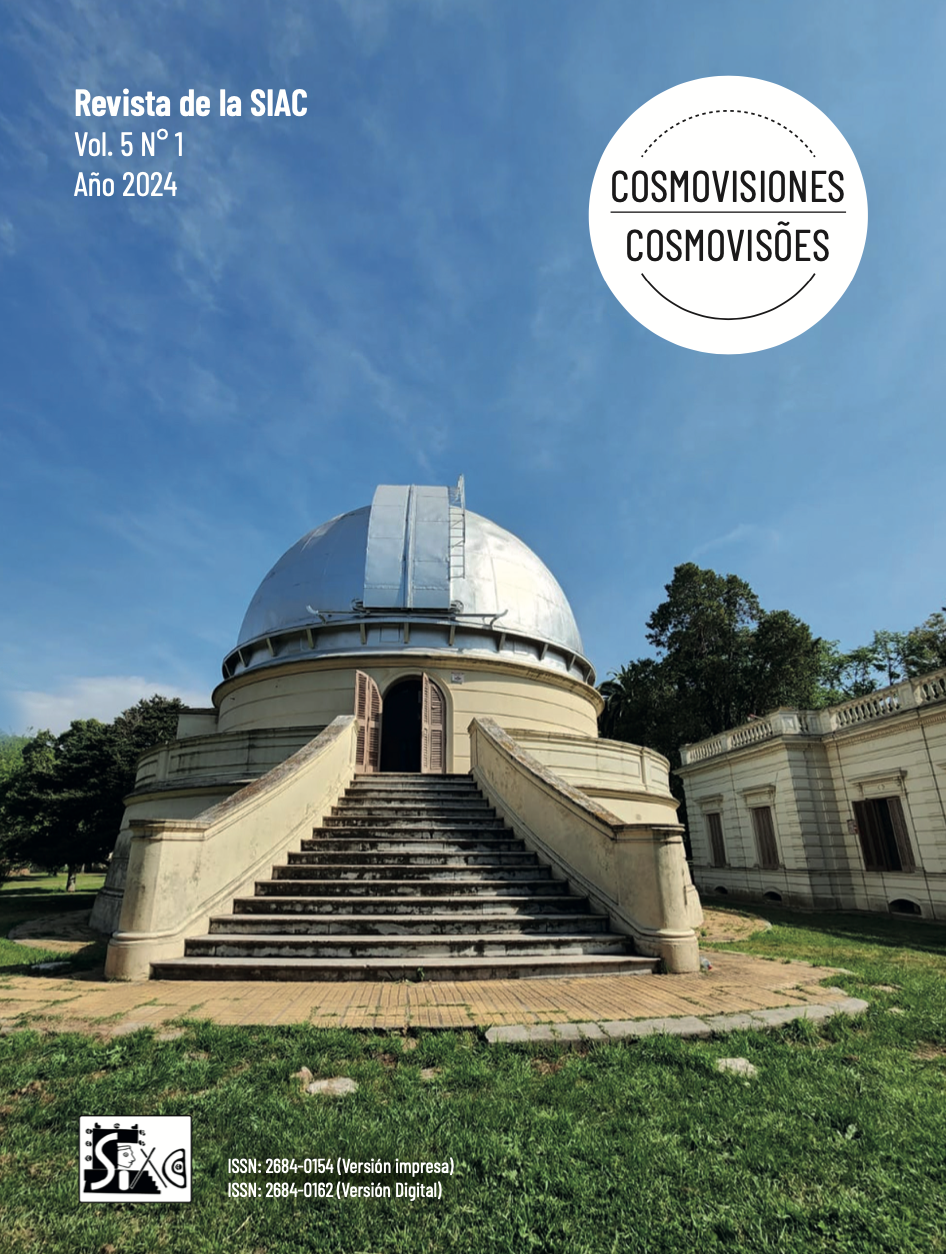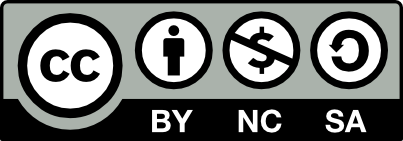La ira del Zemi: predicción de huracanes en el Caribe por los arahuacos
DOI:
https://doi.org/10.24215/26840162e024Palabras clave:
Caribe, etnoastronomía, arqueología precolombina, culturas del bosque tropical, predicción meteorológicaResumen
Basándose en más de veinte años de investigación y experiencia de campo a largo plazo en el Neotrópico, este artículo sostiene la existencia de una metodología indígena para predecir la llegada de huracanes en el Caribe. El yacimiento arqueológico estudiado es el de Anse à la Gourde, en Guadalupe (Antillas francesas), que se analiza en conjunción con una base teórica que se apoya en la etnoastronomía y las cosmologías indígenas amazónicas. La conceptualización de este estudio se remonta a una experiencia del autor durante una escuela de campo arqueológica en 1995, y ha sido a través de la “perspectiva del habitar” que el autor ha cambiado de paradigmas y ha podido dar sentido a sus percepciones originales. Durante el desarrollo de esta innovadora hipótesis sobre la predicción de huracanes por pueblos indígenas del Caribe antes de la llegada de Cristóbal Colón, ha surgido una hipótesis alternativa sobre un momento crucial en la arqueología del Caribe, específicamente sobre el final del Saladoide, alrededor del año 800 d.C.
Descargas
Citas
Ahlbrinck, W., 1931. Encyclopaedie der Karaïben, behelzendtaal, zeden en gewoontendezer Indianen. Verhan- delingen der Koninklijke Akademie van Wetenschappente Amsterdam Afdeling Letterkunde NieuweReeks27(1). Amsterdam: Koninklijke Akademie van Wetenschappen.
Alegria, R. E., 1983. Ball Courts and Ceremonial Plazas in the West Indies. New Haven, Connecticut: Yale University Press.
Anschuetz, K. F., H. Wilshusen and C. L. Scheick, 2001. “An Archaeology of Landscapes: Perspectives and Directions”. Journal of Archaeological Research 9 (2): 157–211.
Aveni, A. F. and G. Urton, eds, 1982. Ethnoastronomy and Archaeoastronomy in the American Tropics. Annals of the New York Academy of Sciences 385. New York: Annals of the New York Academy of Sciences.
Beets, C. J., S. R. Troelstra, P. M. Grootes, M. J. Nadeau, K. van der Borg, C. L. Hofman and M. L. P Hoogland, 2006. “Climate and Pre-Columbian Settlement at Anse à la Gourde, Guadeloupe, Northeastern Caribbean”. Geoarchaeology 21 (3):271–280.
Boomert, A., 2000. Trinidad, Tobago and the Lower Orinoco Interaction Sphere. Alkmaar, Netherlands: Cairi.
Bradley, R., 2003. “Seeing Things: Perception, Experience and the Constraints of Excavation”. Journal of Social Archaeology 3 (2): 151–168.
Breton, R., 1999 [1665]. Dictionnaire Caraïbe–Français. Paris: Karthala – IRD. Combined edition with R. Breton, Dictionnaire Français–Caraïbe (1666). First published Avxerre: Gilles Bovqvut; facsimile edition 1892, Leipzig: B. G. Teubner.
Butt Colson, A. and C. de Armellada, 2001. “The Pleiades, Hayades and Orion (Tamökan) in the Conceptual and Ritual Systems of Kapon and Pemon Groups in the Guiana Highlands”. Archaeology and Anthropology: Journal of the Walter Roth Museum of Anthropology 13: 8–46.
Columbus, C. 1992. The Four Voyages, trans. J. M. Cohen. Harmondsworth, UK: Penguin.
Coudreau, H., 1893. Chez nos indiens: quatre années dans la Guyane française (1887–1891). Paris: Hachette.
deGoeje, C.H., 1941.“De Oayana-Indianen”. Bijdragentotde Taal-, Landen Volkenkunde van Nederlandsch Indië 100:70–125.
deGoeje, C. H., 1943. “Philosophy, Initiation and Myths of the Indians of Guiana and Adjacent Countries”. International Archiv für Ethnographie 44:1–136.
de la Borde, S., 1674. Relation del’ origine, moeurs, coustumes religion, guerres et voyages des Caraibes, sauvages des isles Antilles de l’Amerique. Tirée du Cabinet de Monsieur Blondel. In Recueil de divers voyages faits en Afrique et en l’Amérique, qui n’ont point este encore publiez. Paris: Billaine.
de Waal, M. 2006. Pre-Columbian Organization and Interaction in the Eastern Guadeloupe Area. PhD diss., Leiden University.
Delpuech, A., C. L. Hofman and M. L. P. Hoogland 2001. “Excavations at the Aite of Anse à la Gourde, Guadeloupe: Organisation, History and Environmental Setting”. Proceedings of the 18th Congress for Caribbean Archaeology of the International Association for Caribbean Archaeology, 156– 161. Grenada: L’Association internationale d’Archéologie de la Caraıbe Région.
Duin, R. S., 1998. Architectural Concepts in Caribbean Archaeology: A Preliminairy Archaeological Report of the Features at Anse à la Gourde, Guadeloupe. The House in Past and Present, in Ethno-History, Ethnography and Ethno-Archaeology.MAdiss., Leiden University.
Duin,R.S.,2000–2001.“A Wayana Potter in the Rain forest of French Guiana/Suriname”. Newsletter of the Department of Pottery Technology (Leiden University) 18–19: 45–58.
Duin, R. S., 2004. “Wanneer de sterren op aarde vallen: sterrenkunde bij de Wayana”. Zenit October: 476–478.
Duin, R. S., 2006. “Wayana Architecture, Constructing after the Myth of Origin”. Symposium vooronderzoek door jonge archeologen (SOJA) Bundel 2005, edited by M. Kerkhof, R. M. R. van Oosten, F. Tomas and C. van Woerdekom, 41–51. Leiden: Stichting Onderzoek Jonge Archeologen.
Duin, R. S., 2009. Wayana Socio-Political Landscapes: Multi-Scalar Regionality and Temporality in Guiana. PhD diss., University of Florida, Gainesville.
Eichholz, D. W., 1976. “Rock Art and Astronomy at Las Flores, Puerto Rico”. In Proceedings of the Seventeenth Congress of the International Association for Caribbean Archaeology, edited by J. H. Winter, 3–19. Rock- ville Centre, New York: Molloy College.
Girard, R.,1963. Les Indiens de l’Amazonie péruvienne. Paris: Payot.
Hofman, C. L., M. L. P. Hoogland and A. Delpuech, eds, 2001.Guadeloupe,Saint- François, Anse à la Gourde. Fouille programmée pluriannuelle 1995-2000. Rapport de synthèse 2000. Unpublished type script, Conseil Régional de la Guadeloupe, Direction Régionale des Affaires Culturelles de Guadeloupe, Municipalité de Saint-François.
Hofman, C. L., A. Delpuech, M. L. P. Hoogland and M. S. de Waal, 2004. “Late Ceramic Age Survey of the Northeastern Islands of the Guadeloupean Archipelago”. In Late Ceramic Age Societies in the Eastern Caribbean, edited by A. Delpuech and C. L.Hofman. Paris Monographs in American Archaeology 14: 159–182. Oxford: British Archaeology Reports.
Hugh-Jones, C., 1979. From the Milk River: Spatial and Temporal Processes in Northwest Amazonia. Cambridge: Cambridge University Press.
Hugh-Jones, S., 1979. The Palm and the Pleiades: Initiation and Cosmology in Nor-thwest Amazonia. Cambridge: Cambridge University Press.
Ingold,T.,1993.“The Temporality of the Landscape”. World Archaeology 25(2):152– 174.
Ingold, T., 1995.“Building, Dwelling, Living: How Animals and People Make Themselves at Home in the World”. In Shifting Contexts: Transformations in Anthropological Knowledge, edited by M. Strathern, 57–80. London and New York: Routledge.
Ingold, T., 2000. The Perception of the Environment: Essays on Livelihood, Dwelling and Skill. London and New York:Routledge.
Jarrell, J. D., M. Mayfield, E. N. Rappaport and C. W. Landsea, 2001. The Deadliest, Costliest, and most Intense United States Hurricanes From 1900 to 2000 (And Other Frequently Requested Hurricane Facts). NOAA Technical Memorandum NWSTPC- 1[online]. Accessed April 2017, http://www.aoml.noaa.gov/hrd/Landsea/deadly/
Jenkins, J. M., 1998. Maya Cosmogenesis 2012: The True Meaning of the Maya Calendar End-Date. Santa Fe, New Mexico: Bear & Co.
Joyce, T. 1916. Central American and West Indian Archaeology: Being an Introduction to Archaeology of the States of Nicaragua, Costa Rica, Panama, and the West Indies. New York: G. P. Putnam and Sons.
Karadimas, D., 2015. “Casse-Tête Caribe, Jeu D’images: Analyses iconographiques des motifs des massues circum-caribes, des ciel-de-cases wayana et des vanneries yekuana”. L’Homme 214 (2): 37–74.
Koch-Grünberg, T., 1909. Zwei Jahreuter den Indianern. Reisen in Nordwest-Brasilien 1903–1905. Berlin: Wasmuth.
Koch-Grünberg, T., 1917–1928. Vom Roroimazum Orinoco: Ergebnisseeiner Reise in Nordbrasilien und Venezuela inden Jahren 1911-1913, 5vols. Stuttgart: Strecker und Schröder.
Lehmann-Nitsche, R., 1924. “La constelación de la Osa Mayor y su concepto como huracán o díos de la tormenta en la esfera del Mar Caribe”. Revista del Museo de La Plata 28: 104–145.
Lévi-Strauss, C., 1964. Le Cruetle Cuit. Mythologiques I. Paris: Plon.
Lovén, S.,1979. Origins of the Tainan Culture, West Indies. New York: AMS Press.
Magaña,E.,1984.“Carib Tribal Astronomy”. Social Science Information 23 (2):341–368.
Magaña, E., 1987. Contribuciones al estudio de la mitología y astronomía de los indios de las Guayanas. Latin American Studies 35. Amsterdam:CEDLA.
Magaña, E., 1988. Orión y la mujer Pléyades. Simbolismo astronómico de los indios kaliña de Surinam. Latin American Studies 44. Amsterdam:CEDLA.
Magaña, E. and F. Jara, 1982. “The Carib Sky”. Journal de la Société des Américanistes 68:105–132.
National Hurricane Center, 2017. National Hurricane Data – Best Track Data (HUR-DAT2) [online]. Accessed December 2017, http://www.nhc.noaa.gov/data/#hurdat
Oliver, J., 1998. El centro ceremonial de Caguana, Puerto Rico: simbolismo iconográfi¬co, cosmovisión y el poderío caciquil Taíno de Boriquén. Oxford: Archaeopress.
Pané, R., 1974 [1493]. Relación acerca de las antiguedades de los Indios. New edition edited by J. J. Arrom. Mexico City: Siglo XXI.
Penard, F. P. and A. P. Penard, 1907. De Menschetende Aanbidders der Zonneslang. Paramaribo: H. B. Heyde.
Penard, F. P. and A. P. Penard, 1908a. De Menschetende Aanbidders der Zonneslang, vol.2: Het Woordvanden Indiaanschen Messias.
Penard, F. P. and A. P. Penard, 1908b.De Menschetende Aanbidders der Zonneslang, vol.3: Neo-sophia of de Cirkelleervantijdenruimte. Paramaribo: H. B. Heyde.
Reichel-Dolmatoff, G., 1975. The Shaman and the Jaguar: A Study of Narcotic Drugs among the Indians of Colombia. Philadelphia: Temple University Press.
Rivière, P., 2006. The Guiana Travels of Robert Schomburgk,1835-1844, vol.2: The Boundary Survey 1840-1844. Ashgate: Hakluyt Society Aldershot.
Robiou Lamarche,S., 1997. La Cosmología Taina y Caribe Insular: sus orígenes suramericanos y sus transformaciones Antillanas. San Juan: Centro de Estudios Avanzados de Puerto Rico.
Robiou Lamarche, S., 2000.“Espacio y tiempo entre los Taínos”. Boletín del Museo del Hombre Dominicano 27 (28):163–171.
Robiou Lamarche, S., 2002. “La Gran Serpiente entre los taínos y caribes de las Antillas”. Latin American Indian Literatures Journal 18 (1):21–40.
Rodriguez Alvarez, A., 2001. Prehistoric Astronomy in Puerto Rico: Caguana Ceremonial Center. A Potential Astronomical Observatory. Unpublished typescript.
Roth, W.E., 1915. “An Inquiry into the Ani¬mism and Folk-Lore of the Guiana Indians”. In Thirtieth Annual Report of the Bureau of American Ethnology to the Secretary of the Smithsonian Institution,1908–1909, 103–386. Washington, DC: US Government Printing Office.
Roth,W.E.,1924.“An Introductory Study of the Arts, Crafts, and Customs of the Guiana Indians”. In Thirty- Eighth Annual Report of the Bureau of American Ethnology to the Secretary of the Smithsonian Institution, 1916–1917,25–720.Washington, DC:US Government Printing Office.
Rouse, I. B., 1992. The Taïnos: Rise and Decline of the People who Greeted Columbus. New Haven, Connecticut: Yale University Press.
Starry Night Backyard version 3.1.2. https://starrynight.com/, accessed July 2002.
Tessmann, G., 1930. Die Indianer Nordost-Perus. Hamburg: Friederichsen, deGruyter & Co.
Thomas, J.,1996. Time, Culture and Identity: An Interpretive Archaeology. London and New York: Routledge.
Urton, G., 1981. At the Cross roads of the Earth and the Sky: An Andean Cosmology. Austin: University of Texas Press.
Watts, D., 1990. The West Indies: Patterns of Development, Culture and Environmental Change since 1492. Cambridge: Cambridge University Press.
Wilbert, J., 1981. “Warao Cosmology and Yekuana Roundhouse Symbolism”. In Myth and the Imaginary in the New World, edited by E. Magaña and P. Mason. Latin American Studies 34: 427–458. Amsterdam: CEDLA [reprint of 1981 Journal of Latin American Lore 7 (1):37–72].
Zuidema, R. T., 1982. “Catachillay: The Role of the Pleiades and of the Southern Cross and a and b Centauri in the Calendar of the Inca”. In Ethnoastronomy and Archaeoastronomy in the American Tropics, edited by A. F. Aveni and G. Urton. Annals of the New York Academy of Sciences 385: 203–230. New York: New York Academy of Sciences.
Descargas
Publicado
Cómo citar
Número
Sección
Licencia
Derechos de autor 2024 Renzo S. Duin

Esta obra está bajo una licencia internacional Creative Commons Atribución-NoComercial-CompartirIgual 4.0.
Los autores que publican en esta revista están de acuerdo con los siguientes términos:
Los autores conservan la autoría intelectual del trabajo y garantizan a la revista el derecho de ser la primera publicación del trabajo.
Los autores pueden compartir el trabajo con un reconocimiento de la autoría y la publicación inicial en esta revista.
Los autores pueden establecer por separado acuerdos adicionales para la distribución no exclusiva de la versión de la obra publicada en la revista (por ejemplo, situarlo en un repositorio institucional o publicarlo en un libro), con un reconocimiento de su publicación inicial en esta revista.
La revista ofrece acceso libre ("open access") a todo su contenido. Los artículos se encuentran disponibles para ser leídos, descargados, copiados, impresos y/o investigados de acuerdo a la licencia Creative Commons: CC BY-NC-SA (Atribución - No Comercial - Compartir Igual-4.0 Internacional)

El contenido de la revista queda completamente disponible a partir de su publicación. Los lectores tienen por obligación citar correctamente a la revista y al autor del contenido descargado
















